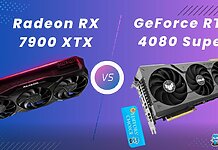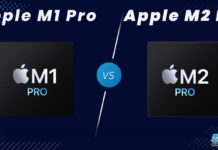Intel’s Raptor Lake CPUs promise a great performance boost over the Alder Lake CPUs despite using the same processing node. In this comparison, I’ll check the performance of Core i7-12700K vs Core i5-13600K to determine if the stated claim is true.
Key Takeaways
- The Core i5-13600K outperformed the Core i7-12700K by 5.8% in my 1440p gaming benchmarks. The productivity benchmarks showed a similar outcome, with the i5 13600K leading by 6.7%.
- Temperatures-wise, I found that the Core i7-12700K showed better thermal skills, running 4.7% cooler than the Core i5-13600K.
- Coming to MSRP, Intel launched the Core i5-13600K with a price tag of $319 and the Core i7-12700K for $409.
- Overall, the i5 13600K should be your pick if you are looking for better productivity and gaming output.
Comparison Table
| CPU | Intel Core i7-12700K | Intel Core i5-13600K |
|---|---|---|
| Architecture | Hybrid Alder Lake | Hybrid Raptor Core |
| Codename | Alder Lake | Raptor Lake |
| CPU Socket | LGA1700 | LGA1700 |
| Unlocked for Overclocking | Yes | Yes |
| Integrated Graphics | Intel UHD 770 | Intel UHD 770 |
| Max. Operating Temperature | 100°C | 100°C |
| Manufacturing Process | Intel 7 (10nm) | Intel 7 (10nm) |
| PCIe Version | Gen 4 | Gen 5 |
| Release Date | Nov 4th, 2021 | Sept 27th, 2022 |
| MSRP | $409 | $319 |
| Best CPU Coolers | Best CPU Coolers for Core i7-12700K | Best CPU Coolers for Core i5-13600K |
| Best Motherboards | Best Motherboards for Core i7-12700K | Best Motherboards for Core i5-13600K |
| Best Motherboards | Best Memory for Core i7-12700K | Best Memory for Core i5-13600K |
| Best Graphics Cards | - | Best GPUs for Core i5-13600K |
Architectural Differences
- Core/Thread Counts: The i7-12700K sports a total of 12 cores, including eight P-cores and four E-cores. In contrast, the i5-13600K has the same number of P-cores but increases the E-core count to six, totalling 14. As for the number of threads, the Core i5-13600K has 20 compared to 24 of the Core i7-12700K.
- Clock Speeds: Moving on to the base frequencies, the i7-12700K clocks 3.6GHz (P-cores) and 2.7GHz (E-cores), while the i5-13600K clocks 3.5GHz (E-cores) and 2.6GHz (P-cores). Regarding boost frequencies, the i7-12700K boosts up to 5GHz (P-cores) and 3.8GHz (E-cores), while the i5-13600K can be pushed to 5.1GHz and 3.9GHz, respectively.
- Memory Support: These processors support both DDR4 and DDR5 memories. The Core i5-13600K improves the DDR5 memory processing speed to 5600 MT/s, while the Core i7-12700K is limited to 4800 MT/s.
- TDP: Both CPUs have a 125-watt base TDP. But on turbo, the i5-13600K pushes up to 181 watts, contrary to the 190 watts of the i7-12700K.
Gaming Benchmarks
A not-so-significant difference in specifications, but how does it impact the gaming performance? I’ll compare the two processors’ performance in six games at 1440P resolution to find out. All games have been tested at Ultra or equivalent preset.
Test Bench
Here’s what my test bench looks like.
- OS – Windows 11
- CPU Cooler – Cooler Master MasterLiquid Lite ML240L RGB
- SSD – XPG Gammix S70 Blade 2TB NVMe
- Power Supply – ENERMAX REVOLUTION D.F. X 1050W
- GPU – GIGABYTE RTX 3070 VISION OC
Assassin’s Creed Valhalla
- Starting my benchmarks with Assassin’s Creed: Valhalla, the i7-12700K maintained 75 FPS, while the i5-13600K outperformed it by 13.3%, delivering 85 FPS.
- Regarding the %1 low FPS, the Core i7-12700K racked up 61 FPS compared to the Core i5-13600K’s score of 63 FPS.
- Temperatures-wise, I observed that both the Core i5-13600K and i7-12700K kept cool at 61°C and 60°C, respectively.
Cyberpunk 2077
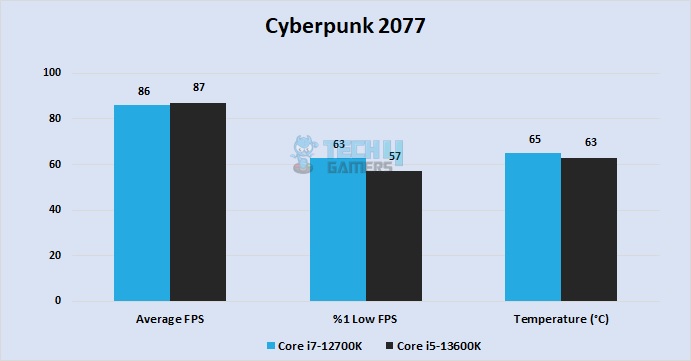
- In my Cyberpunk 2077 gameplay, the competition was fierce. Core i7-12700K scored 86 FPS on average, just one frame behind the Core i5-13600K at 87 FPS.
- Analyzing the %1 low FPS scores, I saw that the Core i7-12700K managed 63 FPS, leading the Core i5-13600K’s score of 57 FPS.
- In Cyberpunk 2077, the i5-13600K ran at 63°C, while the i7-12700K reached 65°C, making it 2 degrees hotter.
God Of War
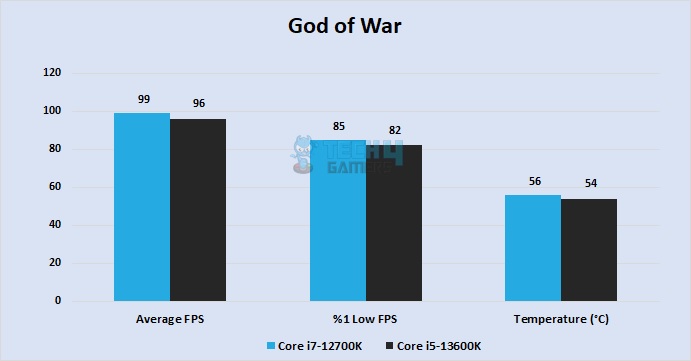
- The i7-12700K consistently delivered 99 FPS, slightly outperforming the Core i5-13600K’s 96 FPS in my God of War test at 1440p resolution.
- The %1 low FPS figures I recorded in this benchmark are 85 FPS for Core i7-12700K and 82 FPS for Core i5-13600K.
- I analyzed that the Core i5-13600K maintained a cool 54°C, while the i7-12700K reached 56°C, running 2 degrees warmer.
Red Dead Redemption 2
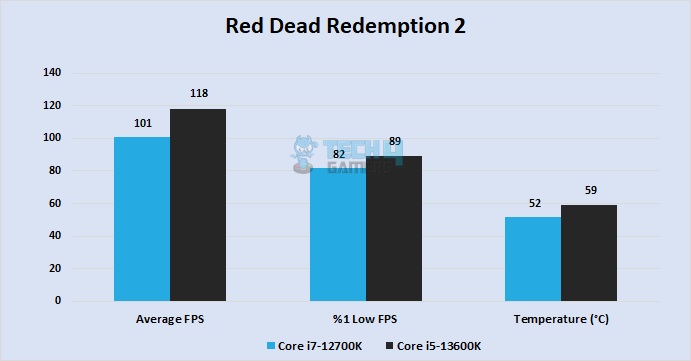
- In my next test game, Red Dead Redemption 2, the Core i7-12700K clocked 101 FPS, but the Core i5-13600K triumphed with an impressive 117 FPS, 16.8% higher.
- As for the %1 low FPS, the Core i5-13600K scored 89 FPS according to my test – keeping ahead by 8.5%.
- While tackling this game, the Core i5-13600K maintained a cool 59°C, but the i7-12700K ran even cooler at 52°C.
Horizon Zero Dawn
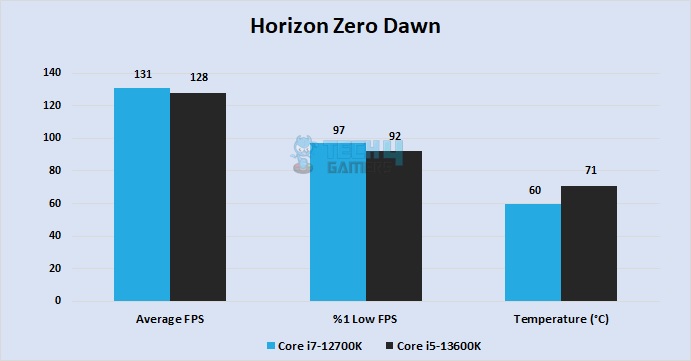
- During my Horizon Zero Dawn gaming test, the Core i7-12700K offered an average FPS of 131, outshining the Core i5-13600K by 2.3%, which scored 128 FPS.
- The Core i7-12700K outclasses its Raptor Lake competitor in terms of the %1 low score by producing 97 FPS compared to 92 FPS for the Core i5-13600K.
- In this gameplay, the Core i5-13600K ran hotter at 71°C, while the i7-12700K kept its cool at 60°C.
Watch Dogs Legion
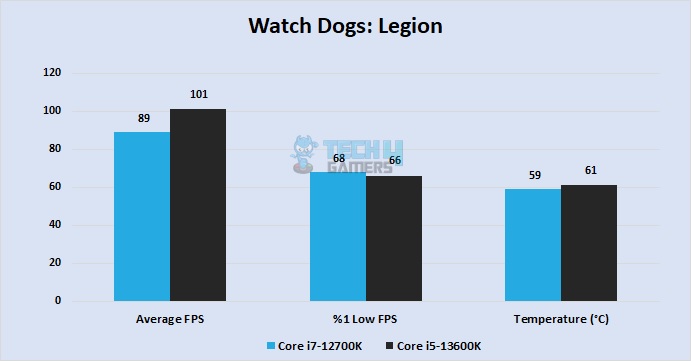
- Watch Dogs: Legion was the last game I tested, and here, the Core i5-13600K excelled with almost 12% better average FPS, reaching 101 FPS, compared to the Core i7-12700K (89 FPS).
- Concerning the %1 low FPS score, the Core i7-12700K took the cake with 68 FPS, while the Core i5-13600K delivered only 66 FPS.
- The Core i5-13600K ran at 61°C during this gameplay while the i7-12700K remained at 59°C.
Productivity
In this section, we compared the productivity benchmarks for the i7 12700K and i5 13600K in order to analyze their performance and help you make a smarter decision.
PassMark
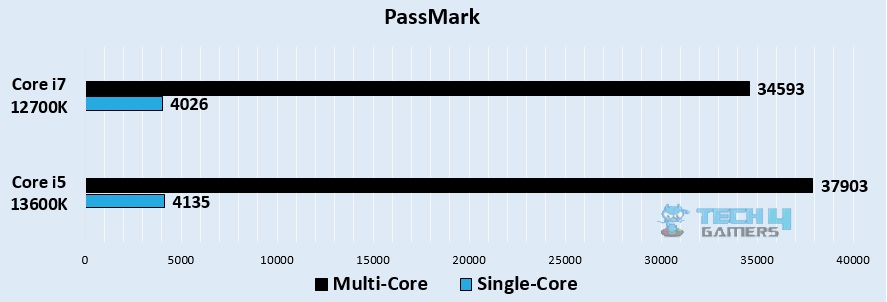
- The i7 12700K depicted a score of 4026 in the single-core benchmark. Meanwhile, its rival performed better with a margin of 2.7%, scoring 4135.
- In the multi-core test, the i7 12700K lagged behind by 9.1% with 34593 points, while the i5 13600K scored 37903.
CineBench R23
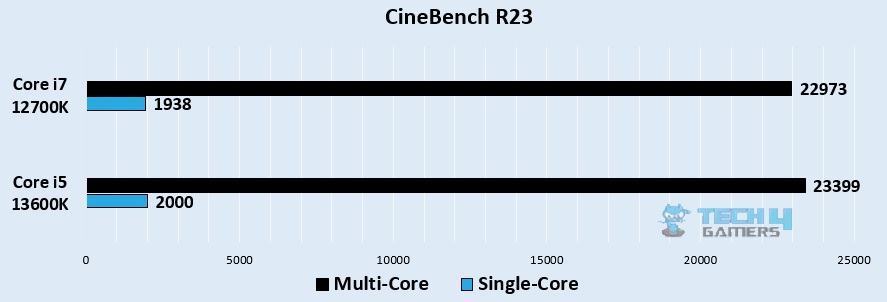
- The i5 13600K led the single-core benchmark test by a slight difference of 3.1%, scoring 2000 points, while the i7 12700K scored 1938 points.
- Once again, the i5 13600K outperformed by 1.8%, with an outstanding score of 23399. On the other hand, the i7 12700K bagged 22973 points in the multi-core benchmark.
GeekBench v6
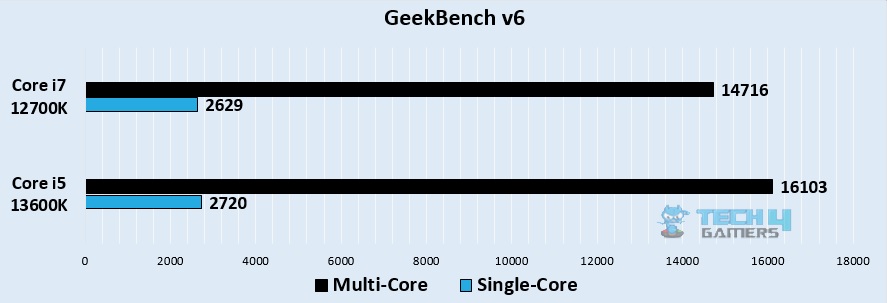
- The single-threaded tests showed the i5 13600K on top with 2720 points when the i7 12700K had only 2629 points.
- For the multi-threaded, the i5 13600K performed up to a score of 16103. On the other hand, the i7 12700K lost by 9%, scoring 14716.
Overall Performance
| Processor | Average FPS | 1% Lows | Productivity (Rating) |
|---|---|---|---|
| Core i7 12700K | 📈96.8 | 📉76 | ✏️7.03/10 |
| Core i5 13600K | 📈102.5 | 📉74.8 | ✏️7.5/10 |
| Winner: Core i5 13600K |
Gaming
Across my gaming benchmarks, the Core i7-12700K provided an average of 96.8 FPS, while the Core i5-13600K delivered 102.5 average FPS. Accounting for these figures, the Core i5-13600K is about 5.8% faster than the Core i7-12700K. I was somewhat surprised as the Core i7-12700K (76 vs 74.8) scored better in terms of the %1 low FPS. The difference is only 1.6%, though.
Productivity
The benchmark tests confirmed that the i5 13600K performs better than the i7 12700K in productivity scores. Although the difference was not huge, the i5 13600K still had a lead in all 3 tests, in both single-core and multi-core performances.
Thermal Performance
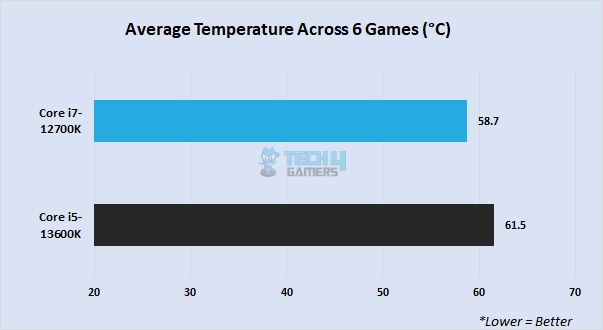
During my gaming session, the average temperature of Core i7-12700K was 58.7°C in contrast with 61.5°C of the Core i5-13600K. So, the Core i5-13600K ran about 4.7% warmer across my 1440p gaming tests, which is quite surprising.
Price And Availability
Fortunately, both CPUs are available cheaper than their launch MSRP (as of November 2023). The Core i7-12700K can be yours for $300 at Amazon, while the i5-13600K would set you back about $270 at NewEgg. The current prices of these CPUs make the Core i5-13600K about 10.0% cheaper than the Core i7-12700K. Moreover, both processors are easily available in the market.
Core i7-12700K Vs Core i5-13600K: Which Processor Do I Recommend?
You’ve reached the end of the Core i7-12700K Vs Core i5-13600K, so it’s time for me to wrap up and determine the better CPU for you.
As I found out, the Core i5-13600K is cheaper than the Core i7-12700K, and it performed marginally better. Moreover, it supports faster DDR5 memory, has more cores, CPU PCIe 5.0 lanes, and a lower boost TDP rating. Even when comparing the productivity scores of both CPUs, the i5 13600K won over the i7 12700K in all the tested benchmarks.
Meanwhile, the only win of the Core i7-12700K was its thermal stability, as it maintained lower temperatures on average. Hence, I recommend the Core i5-13600K over the Core i7-12700K.
Pros And Cons
| Intel Core i7-12700K | Intel Core i5-13600K | ||
|---|---|---|---|
| Pros | Cons | Pros | Cons |
| Better thermal performance | Relatively mediocre value | 5.1 GHz boost clock | Beaten in thermal performance |
| 5.0 GHz boost clock | Beaten in gaming performance | Improved DDR5 memory speed | High power draw |
Common Questions Answered
The Intel core i5-13600K performs better in videography and photo editing. Its Adobe Photoshop scores are higher than those of core i7-12700K.
The i5 13600K performed marginally better in multi-threaded benchmarks, making it a wiser choice for multitasking.
Yes, both the CPUs are unlocked for overclocking.
The gaming performance of the Intel core i5-13600K is superior. However, the core i7-12700K’s performance is not much different compared to core i5-13600K.
The Intel core i5-13600K provides better bang for the buck. Because its price is less than the core i7-12700K and it also has improved performance, Intel i5-13600K is a more suitable option.
More From Core i7-12700K:
More From Core i5-13600K:
Thank you! Please share your positive feedback. 🔋
How could we improve this post? Please Help us. 😔
Feedback By:
[Comparisons Expert]
Abdemanaf is a skilled creative writer who has been honing his craft since 2011. While initially working in different fields, he found a passion for technology and has been exploring the tech world since early 2015. Over the years, he has developed an in-depth knowledge of the latest tech trends and product offerings by various companies.
Abdemanaf’s writing reflects his analytical mindset and ability to think critically. He has a knack for breaking down complex technical information into easily digestible pieces, making his articles engaging and accessible to readers from all backgrounds. In February 2022, he joined Tech4Gamers as a blog and product comparison writer, where he has been able to hone his skills further.
As a writer, Abdemanaf is dedicated to staying up-to-date with the latest technological advancements and trends, enabling him to provide readers with the most relevant and accurate information. He is always eager to learn more and is constantly seeking new challenges to improve his skills.
Get In Touch: manaf@tech4gamers.com


 Threads
Threads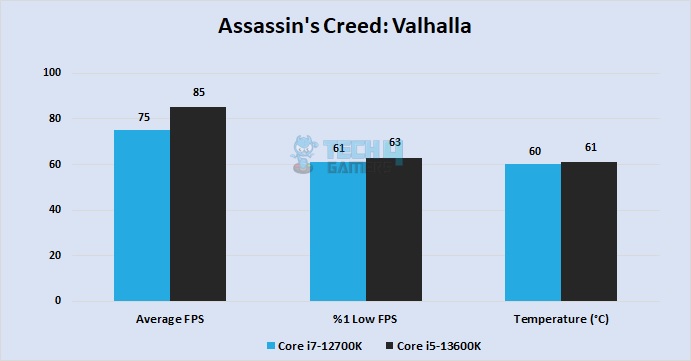
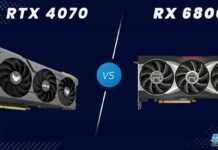
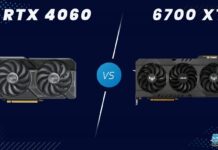
![GTX 1660 Ti Vs RTX 3050 [We Tested Both]](https://tech4gamers.com/wp-content/uploads/2023/06/GPU-Comparison-Template-NEW-1-1-218x150.jpg)
